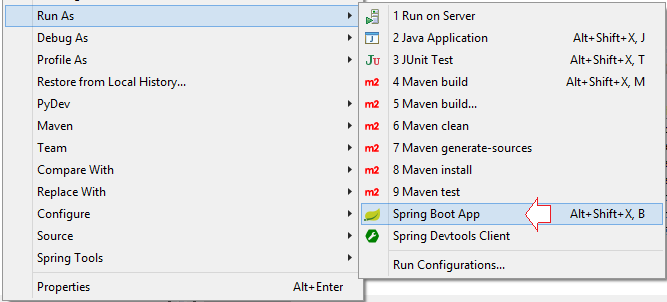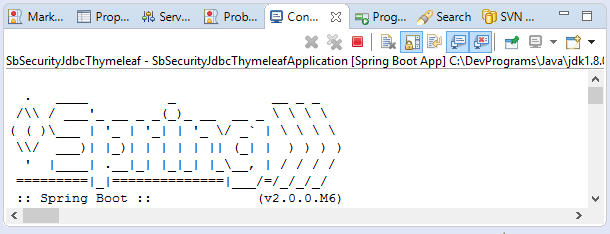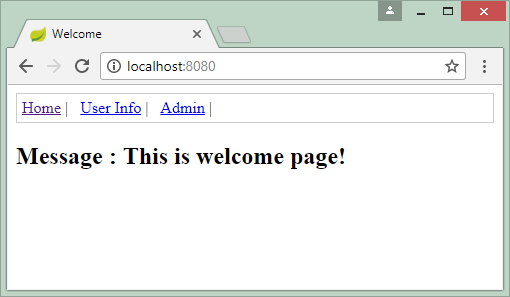Создайте приложение для входа с Spring Boot, Spring Security, Spring JDBC
1. Цель примера
Статья основана на:
Spring Boot 2.x
Spring Security
Spring JDBC
Thymeleaf
Database: MySQL, SQL Server, Oracle, Postgres
В данной статье я покажу вам как создать приложение Login, используя Spring Boot + Spring Security + JDBC + Thymeleaf. И объясню принцип работы Spring Security.
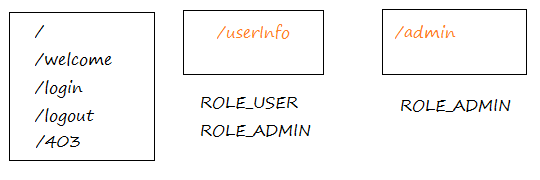
Пользователь обязан войти в систему, чтобы просмотреть защищенные страницы:
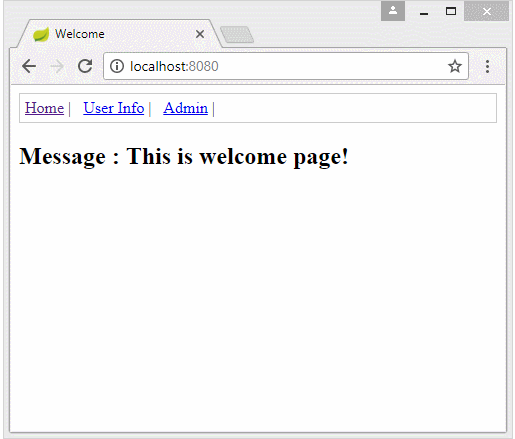
Пользователи, которые вошеи в систему могут просмотреть страницы только в рамках их роли. Если они будут просматривать страницы вне их роли, доступ будет отказан.
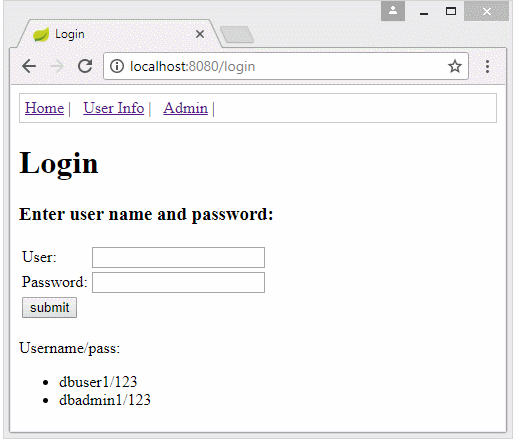
2. Приготовить базу данных
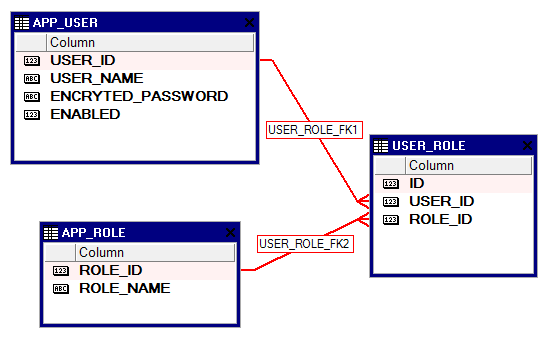
MySQL
-- Create table
create table APP_USER
(
USER_ID BIGINT not null,
USER_NAME VARCHAR(36) not null,
ENCRYTED_PASSWORD VARCHAR(128) not null,
ENABLED BIT not null
) ;
--
alter table APP_USER
add constraint APP_USER_PK primary key (USER_ID);
alter table APP_USER
add constraint APP_USER_UK unique (USER_NAME);
-- Create table
create table APP_ROLE
(
ROLE_ID BIGINT not null,
ROLE_NAME VARCHAR(30) not null
) ;
--
alter table APP_ROLE
add constraint APP_ROLE_PK primary key (ROLE_ID);
alter table APP_ROLE
add constraint APP_ROLE_UK unique (ROLE_NAME);
-- Create table
create table USER_ROLE
(
ID BIGINT not null,
USER_ID BIGINT not null,
ROLE_ID BIGINT not null
);
--
alter table USER_ROLE
add constraint USER_ROLE_PK primary key (ID);
alter table USER_ROLE
add constraint USER_ROLE_UK unique (USER_ID, ROLE_ID);
alter table USER_ROLE
add constraint USER_ROLE_FK1 foreign key (USER_ID)
references APP_USER (USER_ID);
alter table USER_ROLE
add constraint USER_ROLE_FK2 foreign key (ROLE_ID)
references APP_ROLE (ROLE_ID);
-- Used by Spring Remember Me API.
CREATE TABLE Persistent_Logins (
username varchar(64) not null,
series varchar(64) not null,
token varchar(64) not null,
last_used timestamp not null,
PRIMARY KEY (series)
);
--------------------------------------
insert into App_User (USER_ID, USER_NAME, ENCRYTED_PASSWORD, ENABLED)
values (2, 'dbuser1', '$2a$10$PrI5Gk9L.tSZiW9FXhTS8O8Mz9E97k2FZbFvGFFaSsiTUIl.TCrFu', 1);
insert into App_User (USER_ID, USER_NAME, ENCRYTED_PASSWORD, ENABLED)
values (1, 'dbadmin1', '$2a$10$PrI5Gk9L.tSZiW9FXhTS8O8Mz9E97k2FZbFvGFFaSsiTUIl.TCrFu', 1);
---
insert into app_role (ROLE_ID, ROLE_NAME)
values (1, 'ROLE_ADMIN');
insert into app_role (ROLE_ID, ROLE_NAME)
values (2, 'ROLE_USER');
---
insert into user_role (ID, USER_ID, ROLE_ID)
values (1, 1, 1);
insert into user_role (ID, USER_ID, ROLE_ID)
values (2, 1, 2);
insert into user_role (ID, USER_ID, ROLE_ID)
values (3, 2, 2);
---SQL Server
-- Create table
create table APP_USER
(
USER_ID BIGINT not null,
USER_NAME VARCHAR(36) not null,
ENCRYTED_PASSWORD VARCHAR(128) not null,
ENABLED BIT not null
) ;
--
alter table APP_USER
add constraint APP_USER_PK primary key (USER_ID);
alter table APP_USER
add constraint APP_USER_UK unique (USER_NAME);
-- Create table
create table APP_ROLE
(
ROLE_ID BIGINT not null,
ROLE_NAME VARCHAR(30) not null
) ;
--
alter table APP_ROLE
add constraint APP_ROLE_PK primary key (ROLE_ID);
alter table APP_ROLE
add constraint APP_ROLE_UK unique (ROLE_NAME);
-- Create table
create table USER_ROLE
(
ID BIGINT not null,
USER_ID BIGINT not null,
ROLE_ID BIGINT not null
);
--
alter table USER_ROLE
add constraint USER_ROLE_PK primary key (ID);
alter table USER_ROLE
add constraint USER_ROLE_UK unique (USER_ID, ROLE_ID);
alter table USER_ROLE
add constraint USER_ROLE_FK1 foreign key (USER_ID)
references APP_USER (USER_ID);
alter table USER_ROLE
add constraint USER_ROLE_FK2 foreign key (ROLE_ID)
references APP_ROLE (ROLE_ID);
-- Used by Spring Remember Me API.
CREATE TABLE Persistent_Logins (
username varchar(64) not null,
series varchar(64) not null,
token varchar(64) not null,
last_used Datetime not null,
PRIMARY KEY (series)
);
--------------------------------------
insert into App_User (USER_ID, USER_NAME, ENCRYTED_PASSWORD, ENABLED)
values (2, 'dbuser1', '$2a$10$PrI5Gk9L.tSZiW9FXhTS8O8Mz9E97k2FZbFvGFFaSsiTUIl.TCrFu', 1);
insert into App_User (USER_ID, USER_NAME, ENCRYTED_PASSWORD, ENABLED)
values (1, 'dbadmin1', '$2a$10$PrI5Gk9L.tSZiW9FXhTS8O8Mz9E97k2FZbFvGFFaSsiTUIl.TCrFu', 1);
---
insert into app_role (ROLE_ID, ROLE_NAME)
values (1, 'ROLE_ADMIN');
insert into app_role (ROLE_ID, ROLE_NAME)
values (2, 'ROLE_USER');
---
insert into user_role (ID, USER_ID, ROLE_ID)
values (1, 1, 1);
insert into user_role (ID, USER_ID, ROLE_ID)
values (2, 1, 2);
insert into user_role (ID, USER_ID, ROLE_ID)
values (3, 2, 2);ORACLE
-- Create table
create table APP_USER
(
USER_ID NUMBER(19) not null,
USER_NAME VARCHAR2(36) not null,
ENCRYTED_PASSWORD VARCHAR2(128) not null,
ENABLED NUMBER(1) not null
) ;
--
alter table APP_USER
add constraint APP_USER_PK primary key (USER_ID);
alter table APP_USER
add constraint APP_USER_UK unique (USER_NAME);
-- Create table
create table APP_ROLE
(
ROLE_ID NUMBER(19) not null,
ROLE_NAME VARCHAR2(30) not null
) ;
--
alter table APP_ROLE
add constraint APP_ROLE_PK primary key (ROLE_ID);
alter table APP_ROLE
add constraint APP_ROLE_UK unique (ROLE_NAME);
-- Create table
create table USER_ROLE
(
ID NUMBER(19) not null,
USER_ID NUMBER(19) not null,
ROLE_ID NUMBER(19) not null
);
--
alter table USER_ROLE
add constraint USER_ROLE_PK primary key (ID);
alter table USER_ROLE
add constraint USER_ROLE_UK unique (USER_ID, ROLE_ID);
alter table USER_ROLE
add constraint USER_ROLE_FK1 foreign key (USER_ID)
references APP_USER (USER_ID);
alter table USER_ROLE
add constraint USER_ROLE_FK2 foreign key (ROLE_ID)
references APP_ROLE (ROLE_ID);
-- Used by Spring Remember Me API.
CREATE TABLE Persistent_Logins (
username varchar2(64) not null,
series varchar2(64) not null,
token varchar2(64) not null,
last_used Date not null,
PRIMARY KEY (series)
);
--------------------------------------
insert into App_User (USER_ID, USER_NAME, ENCRYTED_PASSWORD, ENABLED)
values (2, 'dbuser1', '$2a$10$PrI5Gk9L.tSZiW9FXhTS8O8Mz9E97k2FZbFvGFFaSsiTUIl.TCrFu', 1);
insert into App_User (USER_ID, USER_NAME, ENCRYTED_PASSWORD, ENABLED)
values (1, 'dbadmin1', '$2a$10$PrI5Gk9L.tSZiW9FXhTS8O8Mz9E97k2FZbFvGFFaSsiTUIl.TCrFu', 1);
---
insert into app_role (ROLE_ID, ROLE_NAME)
values (1, 'ROLE_ADMIN');
insert into app_role (ROLE_ID, ROLE_NAME)
values (2, 'ROLE_USER');
---
insert into user_role (ID, USER_ID, ROLE_ID)
values (1, 1, 1);
insert into user_role (ID, USER_ID, ROLE_ID)
values (2, 1, 2);
insert into user_role (ID, USER_ID, ROLE_ID)
values (3, 2, 2);
---
Commit;Postgres
-- Create table
create table APP_USER
(
USER_ID BIGINT not null,
USER_NAME VARCHAR(36) not null,
ENCRYTED_PASSWORD VARCHAR(128) not null,
ENABLED Int not null
) ;
--
alter table APP_USER
add constraint APP_USER_PK primary key (USER_ID);
alter table APP_USER
add constraint APP_USER_UK unique (USER_NAME);
-- Create table
create table APP_ROLE
(
ROLE_ID BIGINT not null,
ROLE_NAME VARCHAR(30) not null
) ;
--
alter table APP_ROLE
add constraint APP_ROLE_PK primary key (ROLE_ID);
alter table APP_ROLE
add constraint APP_ROLE_UK unique (ROLE_NAME);
-- Create table
create table USER_ROLE
(
ID BIGINT not null,
USER_ID BIGINT not null,
ROLE_ID BIGINT not null
);
--
alter table USER_ROLE
add constraint USER_ROLE_PK primary key (ID);
alter table USER_ROLE
add constraint USER_ROLE_UK unique (USER_ID, ROLE_ID);
alter table USER_ROLE
add constraint USER_ROLE_FK1 foreign key (USER_ID)
references APP_USER (USER_ID);
alter table USER_ROLE
add constraint USER_ROLE_FK2 foreign key (ROLE_ID)
references APP_ROLE (ROLE_ID);
-- Used by Spring Remember Me API.
CREATE TABLE Persistent_Logins (
username varchar(64) not null,
series varchar(64) not null,
token varchar(64) not null,
last_used timestamp not null,
PRIMARY KEY (series)
);
--------------------------------------
insert into App_User (USER_ID, USER_NAME, ENCRYTED_PASSWORD, ENABLED)
values (2, 'dbuser1', '$2a$10$PrI5Gk9L.tSZiW9FXhTS8O8Mz9E97k2FZbFvGFFaSsiTUIl.TCrFu', 1);
insert into App_User (USER_ID, USER_NAME, ENCRYTED_PASSWORD, ENABLED)
values (1, 'dbadmin1', '$2a$10$PrI5Gk9L.tSZiW9FXhTS8O8Mz9E97k2FZbFvGFFaSsiTUIl.TCrFu', 1);
---
insert into app_role (ROLE_ID, ROLE_NAME)
values (1, 'ROLE_ADMIN');
insert into app_role (ROLE_ID, ROLE_NAME)
values (2, 'ROLE_USER');
---
insert into user_role (ID, USER_ID, ROLE_ID)
values (1, 1, 1);
insert into user_role (ID, USER_ID, ROLE_ID)
values (2, 1, 2);
insert into user_role (ID, USER_ID, ROLE_ID)
values (3, 2, 2);
---
Commit;3. Создать Spring Boot Project
На Eclipse создать проект Spring Boot.
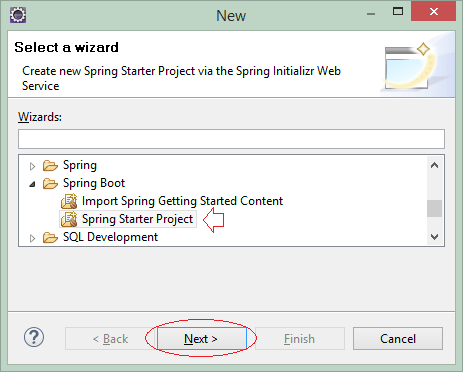
Ввести:
- Name: SbSecurityJdbcThymeleaf
- Group: org.o7planning
- Artifact: SbSecurityJdbcThymeleaf
- Description: Spring Boot + JDBC + Security + Thymeleaf
- Package: org.o7planning.sbsecurity
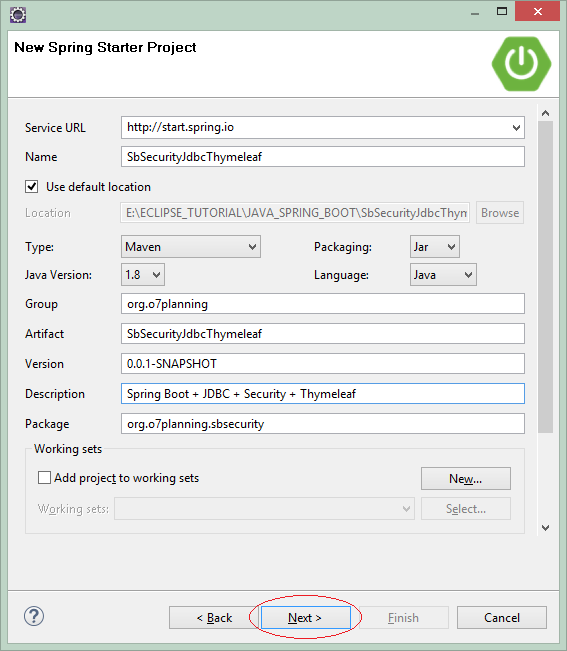
Следующий шаг, вам нужно выбрать технологии и библиотеки которые будут использованы ( В данной статье мы подключимся к базе данных Oracle, MySQL, SQL Server или Postgres).
Database Libraries:
- MySQL
- PostgresSQL
- SQL Server
- Web
- Thymeleaf
- Security
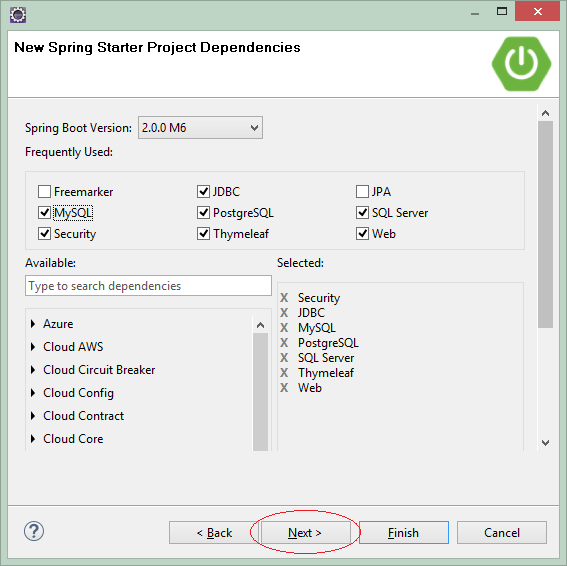
OK Project создан.
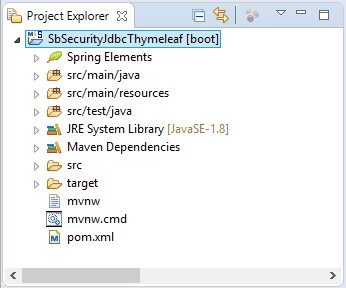
SbSecurityJdbcThymeleafApplication.java
package org.o7planning.sbsecurity;
import org.springframework.boot.SpringApplication;
import org.springframework.boot.autoconfigure.SpringBootApplication;
@SpringBootApplication
public class SbSecurityJdbcThymeleafApplication {
public static void main(String[] args) {
SpringApplication.run(SbSecurityJdbcThymeleafApplication.class, args);
}
}4. Конфигурация pom.xml
Если вы используете базу данных Oracle, вам нужно объявить нужную библиотеку для Oracle в файле pom.xml:
** Oracle **
<dependencies>
.....
<dependency>
<groupId>com.oracle</groupId>
<artifactId>ojdbc6</artifactId>
<version>11.2.0.3</version>
</dependency>
.....
</dependencies>
<repositories>
....
<!-- Repository for ORACLE JDBC Driver -->
<repository>
<id>codelds</id>
<url>https://code.lds.org/nexus/content/groups/main-repo</url>
</repository>
.....
</repositories>Если вы подключаете к базе данных SQL Service, вы можете использовать одну из 2 библиотек JTDS или Mssql-Jdbc:
** SQL Server **
<dependencies>
.....
<dependency>
<groupId>com.microsoft.sqlserver</groupId>
<artifactId>mssql-jdbc</artifactId>
<scope>runtime</scope>
</dependency>
<dependency>
<groupId>net.sourceforge.jtds</groupId>
<artifactId>jtds</artifactId>
<scope>runtime</scope>
</dependency>
.....
</dependencies>Полное содержание файла pom.xml:
pom.xml
<?xml version="1.0" encoding="UTF-8"?>
<project xmlns="http://maven.apache.org/POM/4.0.0"
xmlns:xsi="http://www.w3.org/2001/XMLSchema-instance"
xsi:schemaLocation="http://maven.apache.org/POM/4.0.0
http://maven.apache.org/xsd/maven-4.0.0.xsd">
<modelVersion>4.0.0</modelVersion>
<groupId>org.o7planning</groupId>
<artifactId>SbSecurityJdbcThymeleaf</artifactId>
<version>0.0.1-SNAPSHOT</version>
<packaging>jar</packaging>
<name>SbSecurityJdbcThymeleaf</name>
<description>Spring Boot + JDBC + Security + Thymeleaf</description>
<parent>
<groupId>org.springframework.boot</groupId>
<artifactId>spring-boot-starter-parent</artifactId>
<version>2.0.0.RELEASE</version>
<relativePath/> <!-- lookup parent from repository -->
</parent>
<properties>
<project.build.sourceEncoding>UTF-8</project.build.sourceEncoding>
<project.reporting.outputEncoding>UTF-8</project.reporting.outputEncoding>
<java.version>1.8</java.version>
</properties>
<dependencies>
<dependency>
<groupId>org.springframework.boot</groupId>
<artifactId>spring-boot-starter-jdbc</artifactId>
</dependency>
<dependency>
<groupId>org.springframework.boot</groupId>
<artifactId>spring-boot-starter-security</artifactId>
</dependency>
<dependency>
<groupId>org.springframework.boot</groupId>
<artifactId>spring-boot-starter-thymeleaf</artifactId>
</dependency>
<dependency>
<groupId>org.springframework.boot</groupId>
<artifactId>spring-boot-starter-web</artifactId>
</dependency>
<dependency>
<groupId>mysql</groupId>
<artifactId>mysql-connector-java</artifactId>
<scope>runtime</scope>
</dependency>
<dependency>
<groupId>org.postgresql</groupId>
<artifactId>postgresql</artifactId>
<scope>runtime</scope>
</dependency>
<dependency>
<groupId>com.microsoft.sqlserver</groupId>
<artifactId>mssql-jdbc</artifactId>
<scope>runtime</scope>
</dependency>
<dependency>
<groupId>net.sourceforge.jtds</groupId>
<artifactId>jtds</artifactId>
<scope>runtime</scope>
</dependency>
<dependency>
<groupId>com.oracle</groupId>
<artifactId>ojdbc6</artifactId>
<version>11.2.0.3</version>
</dependency>
<dependency>
<groupId>org.springframework.boot</groupId>
<artifactId>spring-boot-starter-test</artifactId>
<scope>test</scope>
</dependency>
<dependency>
<groupId>org.springframework.security</groupId>
<artifactId>spring-security-test</artifactId>
<scope>test</scope>
</dependency>
</dependencies>
<build>
<plugins>
<plugin>
<groupId>org.springframework.boot</groupId>
<artifactId>spring-boot-maven-plugin</artifactId>
</plugin>
</plugins>
</build>
<repositories>
<!-- Repository for ORACLE JDBC Driver -->
<repository>
<id>codelds</id>
<url>https://code.lds.org/nexus/content/groups/main-repo</url>
</repository>
</repositories>
</project>5. Конфигурация Datasource
Чтобы Spring подключился к базе данныхвам нужно конфигурировать необходимые параметрыв файле application.properties.
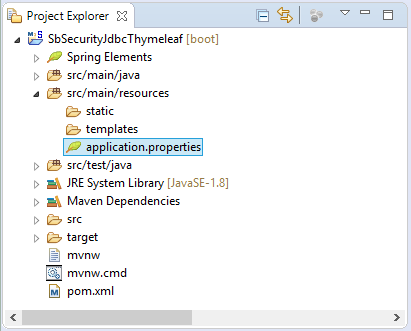
application.properties (ORACLE)
# Database Connection
spring.datasource.driver-class-name=oracle.jdbc.driver.OracleDriver
spring.datasource.url=jdbc:oracle:thin:@localhost:1521:db12c
spring.datasource.username=Test
spring.datasource.password=test001
# Other properties ..application.properties (SQL Server + JTDS driver)
# Database Connection
spring.datasource.driver-class-name=net.sourceforge.jtds.jdbc.Driver
spring.datasource.url=jdbc:jtds:sqlserver://localhost:1433/simplehr;instance=SQLEXPRESS
spring.datasource.username=sa
spring.datasource.password=12345
# Other properties ..application.properties (SQL Server + Mssql-jdbc Driver)
# Database Connection
spring.datasource.driver-class-name=com.microsoft.sqlserver.jdbc.SQLServerDriver
spring.datasource.url=jdbc:sqlserver://tran-vmware-pc\\SQLEXPRESS:1433;databaseName=Test
spring.datasource.username=sa
spring.datasource.password=12345
# Other properties ..application.properties (MySQL)
# Database Connection
spring.datasource.driver-class-name=com.mysql.jdbc.Driver
spring.datasource.url=jdbc:mysql://localhost:3306/mydatabase
spring.datasource.username=root
spring.datasource.password=12345
# Other properties ..application.properties (Postgres)
# Database Connection
spring.datasource.driver-class-name=org.postgresql.Driver
spring.datasource.url=jdbc:postgresql://localhost:5432/mydatabase
spring.datasource.username=postgres
spring.datasource.password=12345
# Other properties ..6. Конфигурация защиты
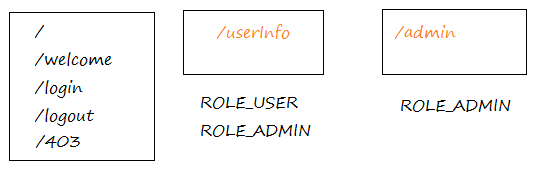
Данное приложение имеет некоторые функции (страницы), которые:
- /userInfo
Это страница просмотра информации пользователя, данная страница требует пользователя войти в систему, и имет роль ROLE_ADMIN или ROLE_USER.
- /admin
Это страница для администратора, требует пользователя войти в систему, и только люди с ролем ROLE_ADMIN имеют право на доступ.
- /. /welcome, /login, /logout, /403
Все другие страницы в приложении не требуют пользователя входить в систему.
Класс WebSecurityConfig используется для конфигурации защиты для приложения. Он аннотирован (annotate) с помощью @Configuration, Данная аннотация говорит Spring что он является классом конфигурации, поэтому он будет анализирован с помощью Spring во время запуска данного приложения.
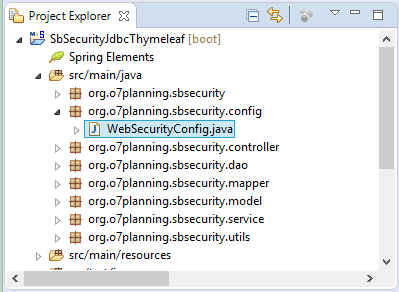
WebSecurityConfig.java
package org.o7planning.sbsecurity.config;
import org.o7planning.sbsecurity.service.UserDetailsServiceImpl;
import org.springframework.beans.factory.annotation.Autowired;
import org.springframework.context.annotation.Bean;
import org.springframework.context.annotation.Configuration;
import org.springframework.security.config.annotation.authentication.builders.AuthenticationManagerBuilder;
import org.springframework.security.config.annotation.web.builders.HttpSecurity;
import org.springframework.security.config.annotation.web.configuration.EnableWebSecurity;
import org.springframework.security.config.annotation.web.configuration.WebSecurityConfigurerAdapter;
import org.springframework.security.crypto.bcrypt.BCryptPasswordEncoder;
@Configuration
@EnableWebSecurity
public class WebSecurityConfig extends WebSecurityConfigurerAdapter {
@Autowired
UserDetailsServiceImpl userDetailsService;
@Bean
public BCryptPasswordEncoder passwordEncoder() {
BCryptPasswordEncoder bCryptPasswordEncoder = new BCryptPasswordEncoder();
return bCryptPasswordEncoder;
}
@Autowired
public void configureGlobal(AuthenticationManagerBuilder auth) throws Exception {
// Setting Service to find User in the database.
// And Setting PassswordEncoder
auth.userDetailsService(userDetailsService).passwordEncoder(passwordEncoder());
}
@Override
protected void configure(HttpSecurity http) throws Exception {
http.csrf().disable();
// The pages does not require login
http.authorizeRequests().antMatchers("/", "/login", "/logout").permitAll();
// /userInfo page requires login as ROLE_USER or ROLE_ADMIN.
// If no login, it will redirect to /login page.
http.authorizeRequests().antMatchers("/userInfo").access("hasAnyRole('ROLE_USER', 'ROLE_ADMIN')");
// For ADMIN only.
http.authorizeRequests().antMatchers("/admin").access("hasRole('ROLE_ADMIN')");
// When the user has logged in as XX.
// But access a page that requires role YY,
// AccessDeniedException will be thrown.
http.authorizeRequests().and().exceptionHandling().accessDeniedPage("/403");
// Config for Login Form
http.authorizeRequests().and().formLogin()//
// Submit URL of login page.
.loginProcessingUrl("/j_spring_security_check") // Submit URL
.loginPage("/login")//
.defaultSuccessUrl("/userAccountInfo")//
.failureUrl("/login?error=true")//
.usernameParameter("username")//
.passwordParameter("password")
// Config for Logout Page
.and().logout().logoutUrl("/logout").logoutSuccessUrl("/logoutSuccessful");
}
}7. Model, Mapper, DAO, WebUtils
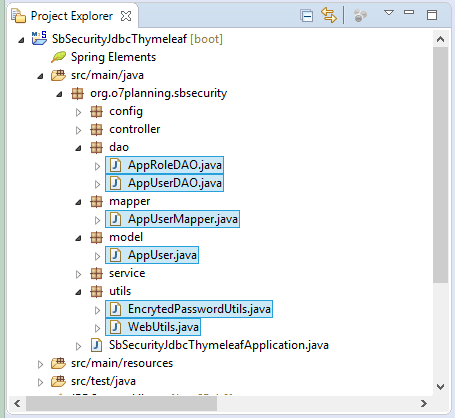
Класс AppUser представляет запись в таблице APP_USER базы данных.
AppUser.java
package org.o7planning.sbsecurity.model;
public class AppUser {
private Long userId;
private String userName;
private String encrytedPassword;
public AppUser() {
}
public AppUser(Long userId, String userName, String encrytedPassword) {
this.userId = userId;
this.userName = userName;
this.encrytedPassword = encrytedPassword;
}
public Long getUserId() {
return userId;
}
public void setUserId(Long userId) {
this.userId = userId;
}
public String getUserName() {
return userName;
}
public void setUserName(String userName) {
this.userName = userName;
}
public String getEncrytedPassword() {
return encrytedPassword;
}
public void setEncrytedPassword(String encrytedPassword) {
this.encrytedPassword = encrytedPassword;
}
@Override
public String toString() {
return this.userName + "/" + this.encrytedPassword;
}
}Класс AppUserMapper используется для сопоставления (mapping) столбцов в таблице APP_USER с полями (field) в классе AppUser (Основывая на команде запроса).
AppUserMapper.java
package org.o7planning.sbsecurity.mapper;
import java.sql.ResultSet;
import java.sql.SQLException;
import org.o7planning.sbsecurity.model.AppUser;
import org.springframework.jdbc.core.RowMapper;
public class AppUserMapper implements RowMapper<AppUser> {
public static final String BASE_SQL //
= "Select u.User_Id, u.User_Name, u.Encryted_Password From App_User u ";
@Override
public AppUser mapRow(ResultSet rs, int rowNum) throws SQLException {
Long userId = rs.getLong("User_Id");
String userName = rs.getString("User_Name");
String encrytedPassword = rs.getString("Encryted_Password");
return new AppUser(userId, userName, encrytedPassword);
}
}Классы DAO (Data Access Object) являются классами использующиеся для доступа в базу данных, например Query, Insert, Update, Delete. Классы DAO обычно аннотированыы с помощью @Repository чтобы сказать Spring управлять ими как Spring BEAN.
Класс AppUserDAO используется для манипуляции с таблицей APP_USER. Он имеет метод поиска пользователя в базе данных соответствующего имени пользователя.
AppUserDAO.java
package org.o7planning.sbsecurity.dao;
import javax.sql.DataSource;
import org.o7planning.sbsecurity.mapper.AppUserMapper;
import org.o7planning.sbsecurity.model.AppUser;
import org.springframework.beans.factory.annotation.Autowired;
import org.springframework.dao.EmptyResultDataAccessException;
import org.springframework.jdbc.core.support.JdbcDaoSupport;
import org.springframework.stereotype.Repository;
import org.springframework.transaction.annotation.Transactional;
@Repository
@Transactional
public class AppUserDAO extends JdbcDaoSupport {
@Autowired
public AppUserDAO(DataSource dataSource) {
this.setDataSource(dataSource);
}
public AppUser findUserAccount(String userName) {
// Select .. from App_User u Where u.User_Name = ?
String sql = AppUserMapper.BASE_SQL + " where u.User_Name = ? ";
Object[] params = new Object[] { userName };
AppUserMapper mapper = new AppUserMapper();
try {
AppUser userInfo = this.getJdbcTemplate().queryForObject(sql, params, mapper);
return userInfo;
} catch (EmptyResultDataAccessException e) {
return null;
}
}
}AppRoleDAO.java
package org.o7planning.sbsecurity.dao;
import java.util.List;
import javax.sql.DataSource;
import org.springframework.beans.factory.annotation.Autowired;
import org.springframework.jdbc.core.support.JdbcDaoSupport;
import org.springframework.stereotype.Repository;
import org.springframework.transaction.annotation.Transactional;
@Repository
@Transactional
public class AppRoleDAO extends JdbcDaoSupport {
@Autowired
public AppRoleDAO(DataSource dataSource) {
this.setDataSource(dataSource);
}
public List<String> getRoleNames(Long userId) {
String sql = "Select r.Role_Name " //
+ " from User_Role ur, App_Role r " //
+ " where ur.Role_Id = r.Role_Id and ur.User_Id = ? ";
Object[] params = new Object[] { userId };
List<String> roles = this.getJdbcTemplate().queryForList(sql, params, String.class);
return roles;
}
}-
WebUtils.java
package org.o7planning.sbsecurity.utils;
import java.util.Collection;
import org.springframework.security.core.GrantedAuthority;
import org.springframework.security.core.userdetails.User;
public class WebUtils {
public static String toString(User user) {
StringBuilder sb = new StringBuilder();
sb.append("UserName:").append(user.getUsername());
Collection<GrantedAuthority> authorities = user.getAuthorities();
if (authorities != null && !authorities.isEmpty()) {
sb.append(" (");
boolean first = true;
for (GrantedAuthority a : authorities) {
if (first) {
sb.append(a.getAuthority());
first = false;
} else {
sb.append(", ").append(a.getAuthority());
}
}
sb.append(")");
}
return sb.toString();
}
}EncrytedPasswordUtils.java
package org.o7planning.sbsecurity.utils;
import org.springframework.security.crypto.bcrypt.BCryptPasswordEncoder;
public class EncrytedPasswordUtils {
// Encryte Password with BCryptPasswordEncoder
public static String encrytePassword(String password) {
BCryptPasswordEncoder encoder = new BCryptPasswordEncoder();
return encoder.encode(password);
}
public static void main(String[] args) {
String password = "123";
String encrytedPassword = encrytePassword(password);
System.out.println("Encryted Password: " + encrytedPassword);
}
}8. UserDetailsService
UserDetailsService это центральный интерфейс в Spring Security. Это сервис для поиска "Аккаунт пользователя и роли того пользователя". Используется Spring Security каждый раз, когда пользователь входит в систему. Поэтому вам нужно написать класс применения (implements) данного интерфейса.
Здесь я создаю класс UserDetailsServiceImpl применения (implements) интерфейса UserDetailsService. Класс UserDetailsServiceImpl аннотирован с помощью @Service чтобы сказать Spring управлять им как Spring BEAN.
UserDetailsServiceImpl.java
package org.o7planning.sbsecurity.service;
import java.util.ArrayList;
import java.util.List;
import org.o7planning.sbsecurity.dao.AppUserDAO;
import org.o7planning.sbsecurity.dao.AppRoleDAO;
import org.o7planning.sbsecurity.model.AppUser;
import org.springframework.beans.factory.annotation.Autowired;
import org.springframework.security.core.GrantedAuthority;
import org.springframework.security.core.authority.SimpleGrantedAuthority;
import org.springframework.security.core.userdetails.User;
import org.springframework.security.core.userdetails.UserDetails;
import org.springframework.security.core.userdetails.UserDetailsService;
import org.springframework.security.core.userdetails.UsernameNotFoundException;
import org.springframework.stereotype.Service;
@Service
public class UserDetailsServiceImpl implements UserDetailsService {
@Autowired
private AppUserDAO appUserDAO;
@Autowired
private AppRoleDAO appRoleDAO;
@Override
public UserDetails loadUserByUsername(String userName) throws UsernameNotFoundException {
AppUser appUser = this.appUserDAO.findUserAccount(userName);
if (appUser == null) {
System.out.println("User not found! " + userName);
throw new UsernameNotFoundException("User " + userName + " was not found in the database");
}
System.out.println("Found User: " + appUser);
// [ROLE_USER, ROLE_ADMIN,..]
List<String> roleNames = this.appRoleDAO.getRoleNames(appUser.getUserId());
List<GrantedAuthority> grantList = new ArrayList<GrantedAuthority>();
if (roleNames != null) {
for (String role : roleNames) {
// ROLE_USER, ROLE_ADMIN,..
GrantedAuthority authority = new SimpleGrantedAuthority(role);
grantList.add(authority);
}
}
UserDetails userDetails = (UserDetails) new User(appUser.getUserName(), //
appUser.getEncrytedPassword(), grantList);
return userDetails;
}
}9. Controllers
MainController.java
package org.o7planning.sbsecurity.controller;
import java.security.Principal;
import org.o7planning.sbsecurity.utils.WebUtils;
import org.springframework.security.core.Authentication;
import org.springframework.security.core.userdetails.User;
import org.springframework.stereotype.Controller;
import org.springframework.ui.Model;
import org.springframework.web.bind.annotation.RequestMapping;
import org.springframework.web.bind.annotation.RequestMethod;
@Controller
public class MainController {
@RequestMapping(value = { "/", "/welcome" }, method = RequestMethod.GET)
public String welcomePage(Model model) {
model.addAttribute("title", "Welcome");
model.addAttribute("message", "This is welcome page!");
return "welcomePage";
}
@RequestMapping(value = "/admin", method = RequestMethod.GET)
public String adminPage(Model model, Principal principal) {
User loginedUser = (User) ((Authentication) principal).getPrincipal();
String userInfo = WebUtils.toString(loginedUser);
model.addAttribute("userInfo", userInfo);
return "adminPage";
}
@RequestMapping(value = "/login", method = RequestMethod.GET)
public String loginPage(Model model) {
return "loginPage";
}
@RequestMapping(value = "/logoutSuccessful", method = RequestMethod.GET)
public String logoutSuccessfulPage(Model model) {
model.addAttribute("title", "Logout");
return "logoutSuccessfulPage";
}
@RequestMapping(value = "/userInfo", method = RequestMethod.GET)
public String userInfo(Model model, Principal principal) {
// (1) (en)
// After user login successfully.
// (vi)
// Sau khi user login thanh cong se co principal
String userName = principal.getName();
System.out.println("User Name: " + userName);
User loginedUser = (User) ((Authentication) principal).getPrincipal();
String userInfo = WebUtils.toString(loginedUser);
model.addAttribute("userInfo", userInfo);
return "userInfoPage";
}
@RequestMapping(value = "/403", method = RequestMethod.GET)
public String accessDenied(Model model, Principal principal) {
if (principal != null) {
User loginedUser = (User) ((Authentication) principal).getPrincipal();
String userInfo = WebUtils.toString(loginedUser);
model.addAttribute("userInfo", userInfo);
String message = "Hi " + principal.getName() //
+ "<br> You do not have permission to access this page!";
model.addAttribute("message", message);
}
return "403Page";
}
}10. Thymeleaf Template
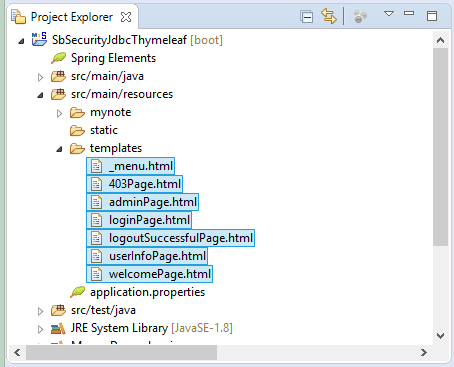
_menu.html используется как часть веб страницы, он погружен в другие страницы, чтобы создать Menu страницы.
_menu.html
<div xmlns:th="http://www.thymeleaf.org"
style="border: 1px solid #ccc;padding:5px;margin-bottom:20px;">
<a th:href="@{/}">Home</a>
|
<a th:href="@{/userInfo}">User Info</a>
|
<a th:href="@{/admin}">Admin</a>
|
<a th:if="${#request.userPrincipal != null}" th:href="@{/logout}">Logout</a>
</div>welcomePage.html
<!DOCTYPE HTML>
<html xmlns:th="http://www.thymeleaf.org">
<head>
<title th:utext="${title}"></title>
</head>
<body>
<!-- Include _menu.html -->
<th:block th:include="/_menu"></th:block>
<h2>Message : <span th:utext="${message}"></span></h2>
</body>
</html>loginPage.html
<!DOCTYPE HTML>
<html xmlns:th="http://www.thymeleaf.org">
<head>
<title>Login</title>
</head>
<body>
<!-- Include _menu.html -->
<th:block th:include="/_menu"></th:block>
<h1>Login</h1>
<!-- /login?error=true -->
<div th:if="${#request.getParameter('error') == 'true'}"
style="color:red;margin:10px 0px;">
Login Failed!!!<br />
Reason :
<span th:if="${#session!= null and #session.getAttribute('SPRING_SECURITY_LAST_EXCEPTION') != null}"
th:utext="${#session.getAttribute('SPRING_SECURITY_LAST_EXCEPTION').message}">
Static summary
</span>
</div>
<h3>Enter user name and password:</h3>
<form name='f' th:action="@{/j_spring_security_check}" method='POST'>
<table>
<tr>
<td>User:</td>
<td><input type='text' name='username' value=''></td>
</tr>
<tr>
<td>Password:</td>
<td><input type='password' name='password' /></td>
</tr>
<tr>
<td><input name="submit" type="submit" value="submit" /></td>
</tr>
</table>
</form>
<br>
Username/pass:
<ul>
<li>dbuser1/123</li>
<li>dbadmin1/123</li>
</ul>
</body>
</html>logoutSuccessfulPage.html
<!DOCTYPE HTML>
<html xmlns:th="http://www.thymeleaf.org">
<head>
<title>Logout</title>
</head>
<body>
<!-- Include _menu.html -->
<th:block th:include="/_menu"></th:block>
<h1>Logout Successful!</h1>
</body>
</html>userInfoPage.html
<!DOCTYPE HTML>
<html xmlns:th="http://www.thymeleaf.org">
<head>
<title>User Info</title>
</head>
<body>
<!-- Include _menu.html -->
<th:block th:include="/_menu"></th:block>
<h2>User Info Page</h2>
<h3>Welcome : <span th:utext="${#request.userPrincipal.name}"></span></h3>
<b>This is protected page!</b>
<br/><br/>
<div th:if="${userInfo != null}" th:utext="${userInfo}"></div>
</body>
</html>adminPage.html
<!DOCTYPE HTML>
<html xmlns:th="http://www.thymeleaf.org">
<head>
<title th:utext="${title}"></title>
</head>
<body>
<!-- Include _menu.html -->
<th:block th:include="/_menu"></th:block>
<h2>Admin Page</h2>
<h3>Welcome :
<span th:utext="${#request.userPrincipal.name}"></span>
</h3>
<b>This is protected page!</b>
<br/><br/>
<div th:if="${userInfo != null}" th:utext="${userInfo}"></div>
</body>
</html>Если пользователь вошел в систему, но досутп в страницу не авторизирован (Не входит в их роль), система отобразит содержание страницы /403 для оповещения запрета доступа в страницу (Access Denied).
403Page.html
<!DOCTYPE HTML>
<html xmlns:th="http://www.thymeleaf.org">
<head>
<title>Access Denied</title>
</head>
<body>
<!-- Include _menu.html -->
<th:block th:include="/_menu"></th:block>
<h3 th:if="${message != null}" th:utext="${message}" style="color: red;"></h3>
<div th:if="${userInfo != null}" th:utext="${userInfo}"></div>
</body>
</html>Руководства Spring Boot
- Установите Spring Tool Suite для Eclipse
- Руководство Spring для начинающих
- Руководство Spring Boot для начинающих
- Общие свойства Spring Boot
- Руководство Spring Boot и Thymeleaf
- Руководство Spring Boot и FreeMarker
- Руководство Spring Boot и Groovy
- Руководство Spring Boot и Mustache
- Руководство Spring Boot и JSP
- Руководство Spring Boot, Apache Tiles, JSP
- Используйте Logging в Spring Boot
- Мониторинг приложений с помощью Spring Boot Actuator
- Создание веб-приложения с несколькими языками с помощью Spring Boot
- Используйте несколько ViewResolver в Spring Boot
- Используйте Twitter Bootstrap в Spring Boot
- Руководство Spring Boot Interceptor
- Руководство Spring Boot, Spring JDBC и Spring Transaction
- Руководство Spring JDBC
- Руководство Spring Boot, JPA и Spring Transaction
- Руководство Spring Boot и Spring Data JPA
- Руководство Spring Boot, Hibernate и Spring Transaction
- Интеграция Spring Boot, JPA и H2 Database
- Руководство Spring Boot и MongoDB
- Используйте несколько DataSources с Spring Boot и JPA
- Используйте несколько DataSource с Spring Boot и RoutingDataSource
- Создайте приложение для входа с Spring Boot, Spring Security, Spring JDBC
- Создайте приложение для входа с Spring Boot, Spring Security, JPA
- Создайте приложение регистрации пользователей с помощью Spring Boot, Spring Form Validation
- Пример OAuth2 Social Login в Spring Boot.
- Запускать фоновые запланированные задачи в Spring
- Пример CRUD Restful Web Service c Spring Boot
- Пример Spring Boot Restful Client c RestTemplate
- Пример CRUD с Spring Boot, REST и AngularJS
- Защита Spring Boot RESTful Service используя Basic Authentication
- Защита Spring Boot RESTful Service используя Auth0 JWT
- Пример Upload file c Spring Boot
- Пример Download file c Spring Boot
- Пример Upload file c Spring Boot и jQuery Ajax
- Пример Upload file c Spring Boot и AngularJS
- Создание веб-приложения для корзины покупок с помощью Spring Boot, Hibernate
- Руководство Spring Email
- Создайте простое приложение Chat с Spring Boot и Websocket
- Разверните приложение Spring Boot на Tomcat Server
- Развертывание приложения Spring Boot на Oracle WebLogic Server
- Установите бесплатный сертификат Let's Encrypt SSL для Spring Boot
- Настройте Spring Boot для перенаправления HTTP на HTTPS
Show More
